Recent Response of Vegetation Water Use Efficiency to Climate Change in Central Asia
Abstract
1. Introduction
2. Materials and Methods
2.1. Study Area
2.2. Data Source and Processing
2.3. WUE Calculation (Including EWUE, SWUE, and PWUE)
2.4. Slope Linear Trend Test and Degree Classification
2.5. Sensitivity Analysis
2.6. Time-Delay Partial Correlation Coefficient Method
- (1)
- Calculate the correlation coefficient between WUE and monthly precipitation and monthly mean temperature under different time delays:
- (2)
- Using the calculation formula of the partial correlation coefficient combined with the correlation coefficient under different delays, the partial correlation sequence under different delays is obtained. The calculation formula is as follows:
2.7. Pearson Correlation Coefficient
2.8. Calculation and Trend Analysis of the Drought Index in Central Asia
3. Results and Discussion
3.1. Temporal and Spatial Changes of WUE
3.2. Sensitivity Analysis of WUE
3.3. Temporal Lag Analysis of WUE on Temperature, Precipitation, and Drought in Central Asia
4. Conclusions
- (1)
- EWUE had a minor decreasing trend; both SWUE and PWUE exhibited a negligible upward trend. The seasonal change of EWUE and PWUE was summer > spring > autumn >winter. EWUE (R = −0.49) was negatively correlated with the altitude factor, whereas SWUE (R = 0.37) and PWUE (R = 0.66) had a positive connection.
- (2)
- The sensitivity of NDVI was consistent with the spatial patterns of precipitation. The sensitivity threshold range for different types of WUE to precipitation was about 200 mm or 1600 mm (low-value valley point) and about 300 mm or 1500 mm (high-value peak point). The optimal temperature thresholds for WUE turning-point adjustments were between 3 and 6 °C (high-value peak point) and 9 to 12 °C (low-value valley point).
- (3)
- The extent to which vegetation use efficiency was affected by precipitation was positively correlated with time lag, while temperature was inversely correlated. The hilly areas had a very long WUE time lag and were less affected by drought, while the plains and desert areas were the opposite. The key regulating elements impacting PWUE-SPEI were changes in water conditions. Temperature changes also formed the principal regulating factors for EWUE-SPEI and SWUE-PDSI in locations with little vegetation cover.
Supplementary Materials
Author Contributions
Funding
Data Availability Statement
Conflicts of Interest
Abbreviations
| εPre | Sensitivity of WUE to Precipitation |
| εTem | Sensitivity of WUE to Temperature |
| εNDVI | Sensitivity of WUE to NDVI |
| ASTER-GDEM | Advanced Spaceborne Thermal Emission and Reflection Radiometer Global Digital Elevation Model |
| CRU | Climatic Research Unit |
| CO2(Chemical formula) | Carbon Dioxide |
| DEM | Digital Elevation Model |
| EC | Eddy Covariance |
| ECMWF—C3S | The European Centre for Medium-Range Weather Forecasts Copernicus Climate Change Service Center |
| ERA5 | The fifth generation of European Reanalysis of the Global Climate |
| ET | Evapotranspiration |
| GEE | Google Earth Engine |
| GPP | Gross Primary Productivity |
| IGBP | International Geosphere and Biosphere Project |
| KAZ | Kazakhstan |
| KGZ | Kyrgyzstan |
| LCC | Maximum Time-delay Correlation Coefficient |
| LPCC | Maximum Time-delay Partial Correlation Coefficient |
| MK | Mann-Kendall |
| MODIS NDVI | Moderate-resolution Imaging Spectroradiometer Normalized Difference Vegetation Index |
| RWT | Correlation Coefficients between WUE and Monthly Mean Temperature |
| RWP | Correlation Coefficients between WUE and Monthly Mean Precipitation |
| RTP | Correlation Coefficients between Monthly Mean Temperature and Monthly Mean Precipitation |
| R(Cor) | Pearson Correlation Coefficient |
| PDSI | Palmer Drought Severity Index |
| PET | Potential Evapotranspiration |
| Pre | Precipitation |
| SDGs | United Nations Sustainable Development Goals |
| SM | Soil Moisture |
| SMUE | Soil Moisture Use Efficiency |
| SPEI | Standardized Precipitation Evapotranspiration Index |
| SW | Soil Water |
| SWUE | Soil Water Use Efficiency |
| Tem | Temperature |
| TJK | Tajikistan |
| TKM | Turkmenistan |
| UZB | Uzbekistan |
| WUE | Water Use Efficiency |
| EWUE | Ecosystem Water Use Efficiency |
| PWUE | Precipitation Water Use Efficiency |
References
- Liu, R.; Dong, X.; Wang, X.; Zhang, P.; Liu, M.; Zhang, Y. Study on the relationship among the urbanization process, ecosystem services and human well-being in an arid region in the context of carbon flow: Taking the Manas river basin as an example. Ecol. Indic. 2021, 132, 108248. [Google Scholar] [CrossRef]
- Zou, J.; Ding, J.; Welp, M.; Huang, S.; Liu, B. Assessing the Response of Ecosystem Water Use Efficiency to Drought During and after Drought Events across Central Asia. Sensors 2020, 20, 581. [Google Scholar] [CrossRef]
- Viets, F.G., Jr. Increasing water use efficiency by soil management. In Plant Environment and Efficient Water Use; John Wiley & Sons, Inc.: Hoboken, NJ, USA, 1966; pp. 259–274. [Google Scholar]
- Adams, M.A.; Turnbull, T.L.; Sprent, J.I.; Buchmann, N. Legumes are different: Leaf nitrogen, photosynthesis, and water use efficiency. Proc. Natl. Acad. Sci. USA 2016, 113, 4098–4103. [Google Scholar] [CrossRef] [PubMed]
- Knauer, J.U.R.; Zaehle, S.O.N.; Reichstein, M.; Medlyn, B.E.; Forkel, M.; Hagemann, S.; Werner, C. The response of ecosystem water-use efficiency to rising atmospheric CO 2 concentrations: Sensitivity and large-scale biogeochemical implications. New Phytol. 2017, 213, 1654–1666. [Google Scholar] [CrossRef] [PubMed]
- Li, Y.; Fan, J.; Hu, Z.; Shao, Q.; Harris, W. Comparison of evapotranspiration components and water-use efficiency among different land use patterns of temperate steppe in the Northern China pastoral-farming ecotone. Int. J. Biometeorol. 2016, 60, 827–841. [Google Scholar] [CrossRef]
- Tian, H.; Chen, G.; Liu, M.; Zhang, C.; Sun, G.; Lu, C.; Xu, X.; Ren, W.; Pan, S.; Chappelka, A. Model estimates of net primary productivity, evapotranspiration, and water use efficiency in the terrestrial ecosystems of the southern United States during 1895–2007. For. Ecol. Manag. 2010, 259, 1327. [Google Scholar] [CrossRef]
- Farquhar, G.D.; Sharkey, T.D. Stomatal Conductance and Photosynthesis. Annu. Rev. Plant Physiol. 1982, 33, 317–345. [Google Scholar] [CrossRef]
- Xue, B.; Guo, Q.; Otto, A.; Xiao, J.; Tao, S.; Li, L. Global patterns, trends, and drivers of water use efficiency from 2000 to 2013. Ecosphere 2015, 6, 1–18. [Google Scholar] [CrossRef]
- Yang, Y.; Guan, H.; Batelaan, O.; McVicar, T.R.; Long, D.; Piao, S.; Liang, W.; Liu, B.; Jin, Z.; Simmons, C.T. Contrasting responses of water use efficiency to drought across global terrestrial ecosystems. Sci. Rep. 2016, 6, 23284. [Google Scholar] [CrossRef]
- Brümmer, C.; Black, T.A.; Jassal, R.S.; Grant, N.J.; Spittlehouse, D.L.; Chen, B.; Nesic, Z.; Amiro, B.D.; Arain, M.A.; Barr, A.G.; et al. How climate and vegetation type influence evapotranspiration and water use efficiency in Canadian forest, peatland and grassland ecosystems. Agric. For. Meteorol. 2012, 153, 14–30. [Google Scholar] [CrossRef]
- He, B.; Wang, H.; Huang, L.; Liu, J.; Chen, Z. A new indicator of ecosystem water use efficiency based on surface soil moisture retrieved from remote sensing. Ecol. Indic. 2017, 75, 10–16. [Google Scholar] [CrossRef]
- Huang, M.; Piao, S.; Zeng, Z.; Peng, S.; Ciais, P.; Cheng, L.; Mao, J.; Poulter, B.; Shi, X.; Yao, Y.; et al. Seasonal responses of terrestrial ecosystem water-use efficiency to climate change. Glob. Chang. Biol. 2016, 22, 2165–2177. [Google Scholar] [CrossRef]
- Huang, M.; Piao, S.; Sun, Y.; Ciais, P.; Cheng, L.; Mao, J.; Poulter, B.; Shi, X.; Zeng, Z.; Wang, Y. Change in terrestrial ecosystem water-use efficiency over the last three decades. Glob. Chang. Biol. 2015, 21, 2366–2378. [Google Scholar] [CrossRef]
- Zhang, T.; Peng, J.; Liang, W.; Yang, Y.; Liu, Y. Spatial–temporal patterns of water use efficiency and climate controls in China’s Loess Plateau during 2000–2010. Sci. Total Environ. 2016, 565, 105–122. [Google Scholar] [CrossRef] [PubMed]
- Kato, T.; Tang, Y. Spatial variability and major controlling factors of CO2 sink strength in Asian terrestrial ecosystems: Evidence from eddy covariance data. Glob. Chang. Biol. 2008, 14, 2333–2348. [Google Scholar] [CrossRef]
- White, M.A.; Brunsell, N.; Schwartz, M.D. Vegetation Phenology in Global Change Studies. In Phenology an Integrative Environmental Science; Springer: Berlin/Heidelberg, Germany, 2003; Volume 39, pp. 453–466. [Google Scholar]
- Zonn, L.S.; Andrey, G.K. The Turkmen Lake Altyn Asyr and Water Resources in Turkmenistan. In The Handbook of Environmental Chemistry; Springer: Berlin/Heidelberg, Germany, 2013. [Google Scholar]
- Li, X.; Farooqi, T.J.A.; Jiang, C.; Liu, S.; Sun, O.J. Spatiotemporal variations in productivity and water use efficiency across a temperate forest landscape of Northeast China. For. Ecosyst. 2019, 6, 22. [Google Scholar] [CrossRef]
- Wonkka, C.L.; Twidwell, D.; Franz, T.E.; Taylor, C.A., Jr.; Rogers, W.E. Persistence of a severe drought increases desertification but not woody dieback in semiarid savanna. Rangel Ecol. Manag. 2016, 69, 491–498. [Google Scholar] [CrossRef]
- Rietkerk, M.; Dekker, S.C.; De Ruiter, P.C.; van de Koppel, J. Self-organized patchiness and catastrophic shifts in ecosystems. Science 2004, 305, 1926–1929. [Google Scholar] [CrossRef]
- Zou, J.; Ding, J.; Welp, M.; Huang, S.; Liu, B. Using MODIS data to analyse the ecosystem water use efficiency spatial-temporal variations across Central Asia from 2000 to 2014. Environ. Res. 2020, 182, 108985. [Google Scholar] [CrossRef]
- Zhu, S.; Zhang, C.; Fang, X.; Cao, L. Interactive and individual effects of multi-factor controls on water use efficiency in Central Asian ecosystems. Environ. Res. Lett. 2020, 15, 84025. [Google Scholar] [CrossRef]
- Han, Q.; Li, C.; Zhao, C.; Zhang, Y.; Li, S. Grazing decreased water use efficiency in Central Asia from 1979 to 2011. Ecol. Model. 2018, 388, 72–79. [Google Scholar] [CrossRef]
- Hu, Z.; Zhang, C.; Hu, Q.; Tian, H. Temperature changes in Central Asia from 1979 to 2011 based on multiple datasets. J. Clim. 2014, 27, 1143–1167. [Google Scholar] [CrossRef]
- Justice, C.O.; Townshend, J.; Vermote, E.F.; Masuoka, E.; Wolfe, R.E.; Saleous, N.; Roy, D.P.; Morisette, J.T. An overview of MODIS Land data processing and product status. Remote Sens. Environ. 2002, 83, 3–15. [Google Scholar] [CrossRef]
- Hersbach, H.; Bell, B.; Berrisford, P.; Hirahara, S.; Hor, A.; Nyi, A.A.S.; Mu, N.; Oz-Sabater, J.I.N.; Nicolas, J.; Peubey, C.; et al. The ERA5 global reanalysis. Q. J. Roy. Meteor. Soc. 2020, 146, 1999–2049. [Google Scholar] [CrossRef]
- Harris, I.; Jones, P.D.; Osborn, T.J.; Lister, D.H. Updated high-resolution grids of monthly climatic observations—The CRU TS3. 10 Dataset. Int. J. Climatol. 2014, 34, 623–642. [Google Scholar] [CrossRef]
- Zheng, H.; Zhang, L.; Zhu, R.; Liu, C.; Sato, Y.; Fukushima, Y. Responses of streamflow to climate and land surface change in the headwaters of the Yellow River Basin. Water Resour. Res. 2009, 45, 641–648. [Google Scholar] [CrossRef]
- Juki, C.D.; Deni, C.; Juki, C.V. Investigating relationships between rainfall and karst-spring discharge by higher-order partial correlation functions. J. Hydrol. 2015, 530, 24–36. [Google Scholar] [CrossRef]
- Wu, D.; Zhao, X.; Liang, S.; Zhou, T.; Huang, K.; Tang, B.; Zhao, W. Time-lag effects of global vegetation responses to climate change. Glob. Chang. Biol. 2015, 21, 3520–3531. [Google Scholar] [CrossRef]
- Benesty, J.; Chen, J.; Huang, Y.; Cohen, I. Pearson correlation coefficient. In Noise Reduction in Speech Processing; Springer: Berlin/Heidelberg, Germany, 2009; pp. 1–4. [Google Scholar]
- Vicente-Serrano, S.M.; Beguería, S.; López-Moreno, J.I. A Multiscalar Drought Index Sensitive to Global Warming: The Standardized Precipitation Evapotranspiration Index. J. Clim. 2010, 23, 1696–1718. [Google Scholar] [CrossRef]
- Trenberth, K.E.; Dai, A.; Gerard, V.D.S.; Jones, P.D.; Barichivich, J.; Briffa, K.R.; Sheffield, J. Global warming and changes in drought. Nat. Clim. Chang. 2013, 4, 17–22. [Google Scholar] [CrossRef]
- Ayantobo, O.O.; Li, Y.; Song, S.; Yao, N. Spatial comparability of drought characteristics and related return periods in mainland China over 1961–2013. J. Hydrol. 2017, 550, 549–567. [Google Scholar] [CrossRef]
- Bastos, A.; Fu, Z.; Ciais, P.; Friedlingstein, P.; Sitch, S.; Pongratz, J.; Weber, U.; Reichstein, M.; Anthoni, P.; Arneth, A.; et al. Impacts of extreme summers on European ecosystems: A comparative analysis of 2003, 2010 and 2018. Philos. Trans. R. Soc. B 2020, 375, 20190507. [Google Scholar] [CrossRef]
- Schaefer, K.; Schwalm, C.R.; Williams, C.; Arain, M.A.; Barr, A.; Chen, J.M.; Davis, K.J.; Dimitrov, D.; Hilton, T.W.; Hollinger, D.Y.; et al. A model-data comparison of gross primary productivity: Results from the North American Carbon Program site synthesis. J. Geophys. Res. Biogeosci. 2012, 117, G03010. [Google Scholar] [CrossRef]
- Aires, L.M.I.; Pio, C.A.; Pereira, J.S. Carbon dioxide exchange above a Mediterranean C3/C4 grassland during two climatologically contrasting years. Glob. Chang. Biol. 2008, 14, 539–555. [Google Scholar] [CrossRef]
- Zheng, H.; Lin, H.; Zhu, X.; Jin, Z.; Bao, H. Divergent spatial responses of plant and ecosystem water-use efficiency to climate and vegetation gradients in the Chinese Loess Plateau. Glob. Planet. Chang. 2019, 181, 102995. [Google Scholar] [CrossRef]
- Zhu, X.; Yu, G.; Wang, Q.; Hu, Z.; Zheng, H.; Li, S.; Sun, X.; Zhang, Y.; Yan, J.; Wang, H.; et al. Spatial variability of water use efficiency in China’s terrestrial ecosystems. Glob. Planet. Chang. 2015, 129, 37–44. [Google Scholar] [CrossRef]
- Ma, Q.; Zhang, J.; Game, A.T.; Chang, Y.; Li, S. Spatiotemporal variability of summer precipitation and precipitation extremes and associated large-scale mechanisms in Central Asia during 1979–2018. J. Hydrol. X 2020, 8, 100061. [Google Scholar] [CrossRef]
- Jennings, K.S.; Winchell, T.S.; Livneh, B.; Molotch, N.P. Spatial variation of the rain-snow temperature threshold across the Northern Hemisphere. Nat. Commun. 2018, 9, 1148. [Google Scholar] [CrossRef]
- Hao, X.; Ma, H.; Hua, D.; Qin, J.; Zhang, Y. Response of ecosystem water use efficiency to climate change in the Tianshan Mountains, Central Asia. Environ. Monit. Assess. 2019, 191, 561. [Google Scholar] [CrossRef] [PubMed]
- Schwartz, R.C.; Baumhardt, R.L.; Evett, S.R. Tillage effects on soil water redistribution and bare soil evaporation throughout a season. Soil Tillage Res. 2010, 110, 221–229. [Google Scholar] [CrossRef]
- Liu, W.; Mo, X.; Liu, S.; Lin, Z.; Lv, C. Attributing the changes of grass growth, water consumed and water use efficiency over the Tibetan Plateau. J. Hydrol. 2021, 598, 126464. [Google Scholar] [CrossRef]
- Liu, N.; Sun, P.; Caldwell, P.V.; Harper, R.; Liu, S.; Sun, G. Trade-off between watershed water yield and ecosystem productivity along elevation gradients on a complex terrain in southwestern China. J. Hydrol. 2020, 590, 125449. [Google Scholar] [CrossRef]
- Krich, C.; Mahecha, M.D.; Migliavacca, M.; De Kauwe, M.G.; Griebel, A.; Runge, J.; Miralles, D.G. Decoupling between ecosystem photosynthesis and transpiration: A last resort against overheating. Environ. Res. Lett. 2022, 17, 44013. [Google Scholar] [CrossRef]
- Tang, X.; Li, H.; Desai, A.R.; Nagy, Z.; Luo, J.; Kolb, T.E.; Olioso, A.; Xu, X.; Yao, L.; Kutsch, W.; et al. How is water-use efficiency of terrestrial ecosystems distributed and changing on Earth? Sci. Rep. 2014, 4, 7483. [Google Scholar] [CrossRef] [PubMed]
- Hao, H.; Li, Z.; Chen, Y.; Xu, J.; Li, S.; Zhang, S. Recent variations in soil moisture use efficiency (SMUE) and its influence factors in Asian drylands. J. Clean. Prod. 2022, 373, 133860. [Google Scholar] [CrossRef]
- Zhan, L.; Shen, T.; Chen, H.; Gu, L.; Zhou, H.; Feng, Q.; Yang, L.; Zhao, N.; Feng, Y. Evaporation Characteristics of a Single Desulfurization Wastewater Droplet in High-temperature Gas. Int. J. Heat Mass Tran. 2022, 185, 122317. [Google Scholar] [CrossRef]
- Kim, H.; Wigneron, J.; Kumar, S.; Dong, J.; Wagner, W.; Cosh, M.H.; Bosch, D.D.; Collins, C.H.; Starks, P.J.; Seyfried, M.; et al. Global scale error assessments of soil moisture estimates from microwave-based active and passive satellites and land surface models over forest and mixed irrigated/dryland agriculture regions. Remote Sens. Environ. 2020, 251, 112052. [Google Scholar] [CrossRef]
- Albergel, C.; Dutra, E.; Munier, S.; Calvet, J.; Munoz-Sabater, J.; de Rosnay, P.; Balsamo, G. ERA-5 and ERA-Interim driven ISBA land surface model simulations: Which one performs better? Hydrol. Earth Syst. Sci. 2018, 22, 3515–3532. [Google Scholar] [CrossRef]
- Henttonen, H.M.; Kinen, M.A.H.; Heiskanen, J.; Peltoniemi, M.; Laur, E.N.A.; Hordo, M. Response of radial increment variation of Scots pine to temperature, precipitation and soil water content along a latitudinal gradient across Finland and Estonia. Agric. For. Meteorol. 2014, 198, 294–308. [Google Scholar] [CrossRef]
- Xie, J.; Chen, J.; Sun, G.; Zha, T.; Yang, B.; Chu, H.; Liu, J.; Wan, S.; Zhou, C.; Ma, H.; et al. Ten-year variability in ecosystem water use efficiency in an oak-dominated temperate forest under a warming climate. Agric. For. Meteorol. 2016, 218, 209–217. [Google Scholar] [CrossRef]
- Pei, T.; Li, X.; Wu, H.; Wu, X.; Chen, Y.; Xie, B. Sensitivity of vegetation water use efficiency to climate and vegetation index in Loess Plateau, China. Trans. Chin. Soc. Agric. Eng. 2019, 35, 119–125. (In Chinese) [Google Scholar]
- Zhou, Y.; Zhang, J.; Yin, C.; Huang, H.; Sun, S.; Meng, P. Empirical analysis of the influences of meteorological factors on the interannual variations in carbon fluxes of a Quercus variabilis plantation. Agric. For. Meteorol. 2022, 326, 109190. [Google Scholar] [CrossRef]
- Reichstein, M.; Camps-Valls, G.; Stevens, B.; Jung, M.; Denzler, J.; Carvalhais, N. Deep learning and process understanding for data-driven Earth system science. Nature 2019, 566, 195–204. [Google Scholar] [CrossRef] [PubMed]
- Sun, Y.; Piao, S.; Huang, M.; Ciais, P.; Zeng, Z.; Cheng, L.; Li, X.; Zhang, X.; Mao, J.; Peng, S.; et al. Global patterns and climate drivers of water-use efficiency in terrestrial ecosystems deduced from satellite-based datasets and carbon cycle models. Glob. Ecol. Biogeogr. 2016, 25, 311–323. [Google Scholar] [CrossRef]
- Li, J.; Deng, J.; Zhou, Y.; Yin, Y.; Wei, Y.; Jing, Y.; Zhang, R. Water-use Efficiency of Typical Afforestation Tree Species in Liaoning, PR China and Their Response to Environmental Factors. Nat. Environ. Pollut. Technol. 2016, 15, 1427. [Google Scholar]
- Pradawet, C.; Khongdee, N.; Pansak, W.; Spreer, W.; Hilger, T.; Cadisch, G. Thermal imaging for assessment of maize water stress and yield prediction under drought conditions. J. Agron. Crop Sci. 2022. [Google Scholar] [CrossRef]
- Kersebaum, K.C.; Stöckle, C.O. Simulation of Climate Change Effects on Evapotranspiration, Photosynthesis, Crop Growth, and Yield Processes in Crop Models. In Modeling Processes and Their Interactions in Cropping Systems: Challenges for the 21st Century; John Wiley & Sons, Inc.: Hoboken, NJ, USA, 2022; pp. 291–331. [Google Scholar]
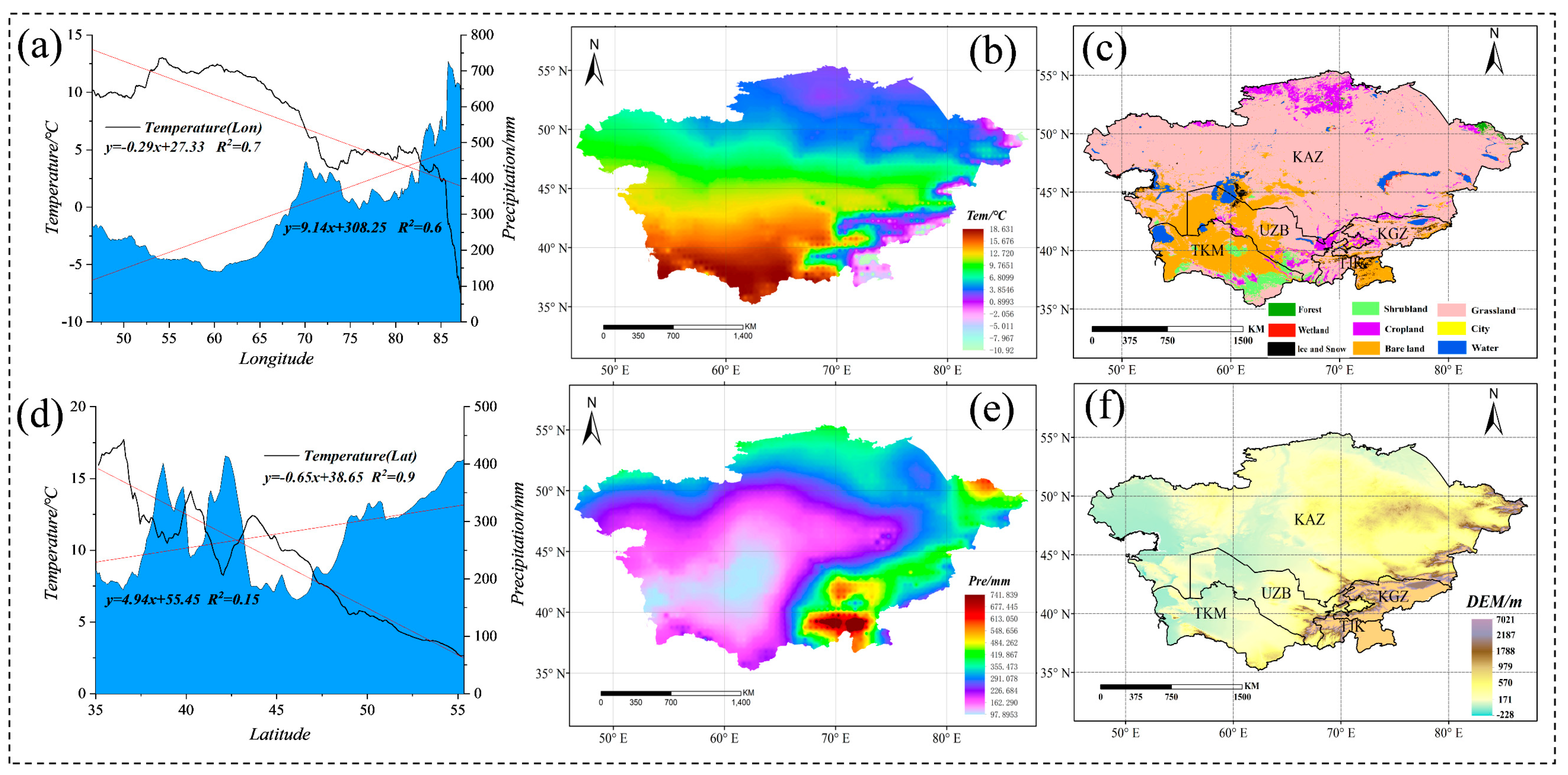

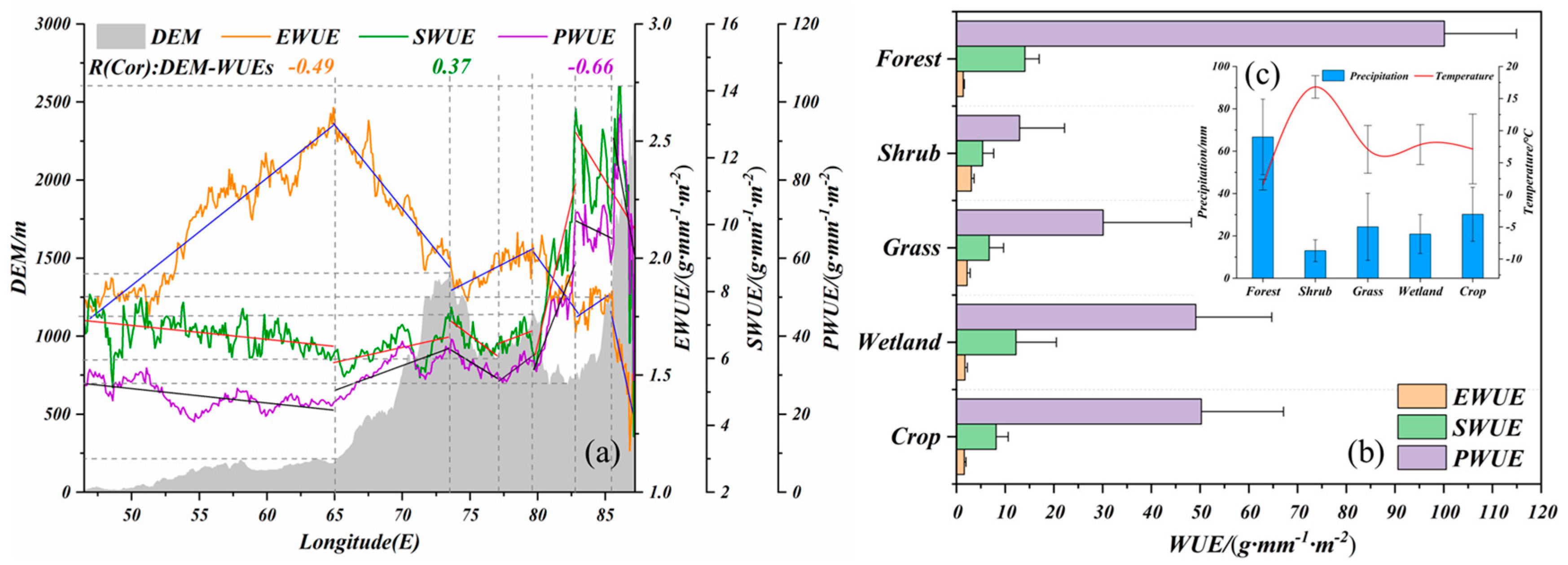
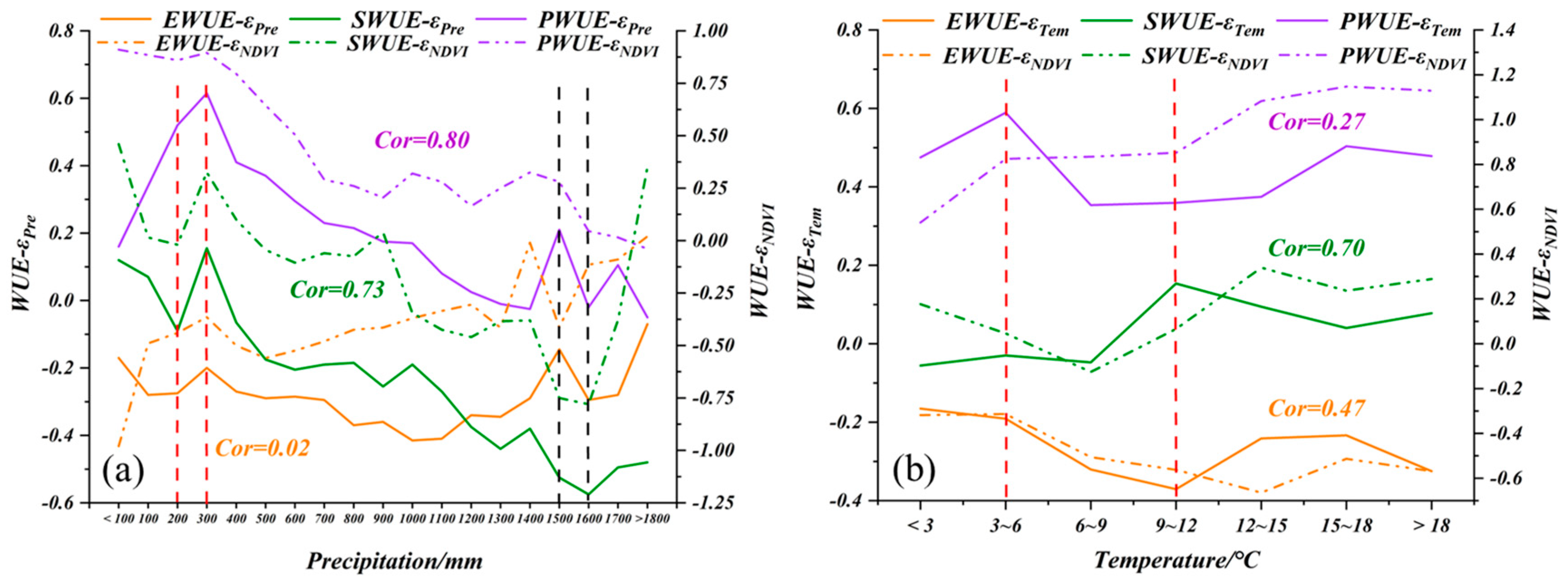
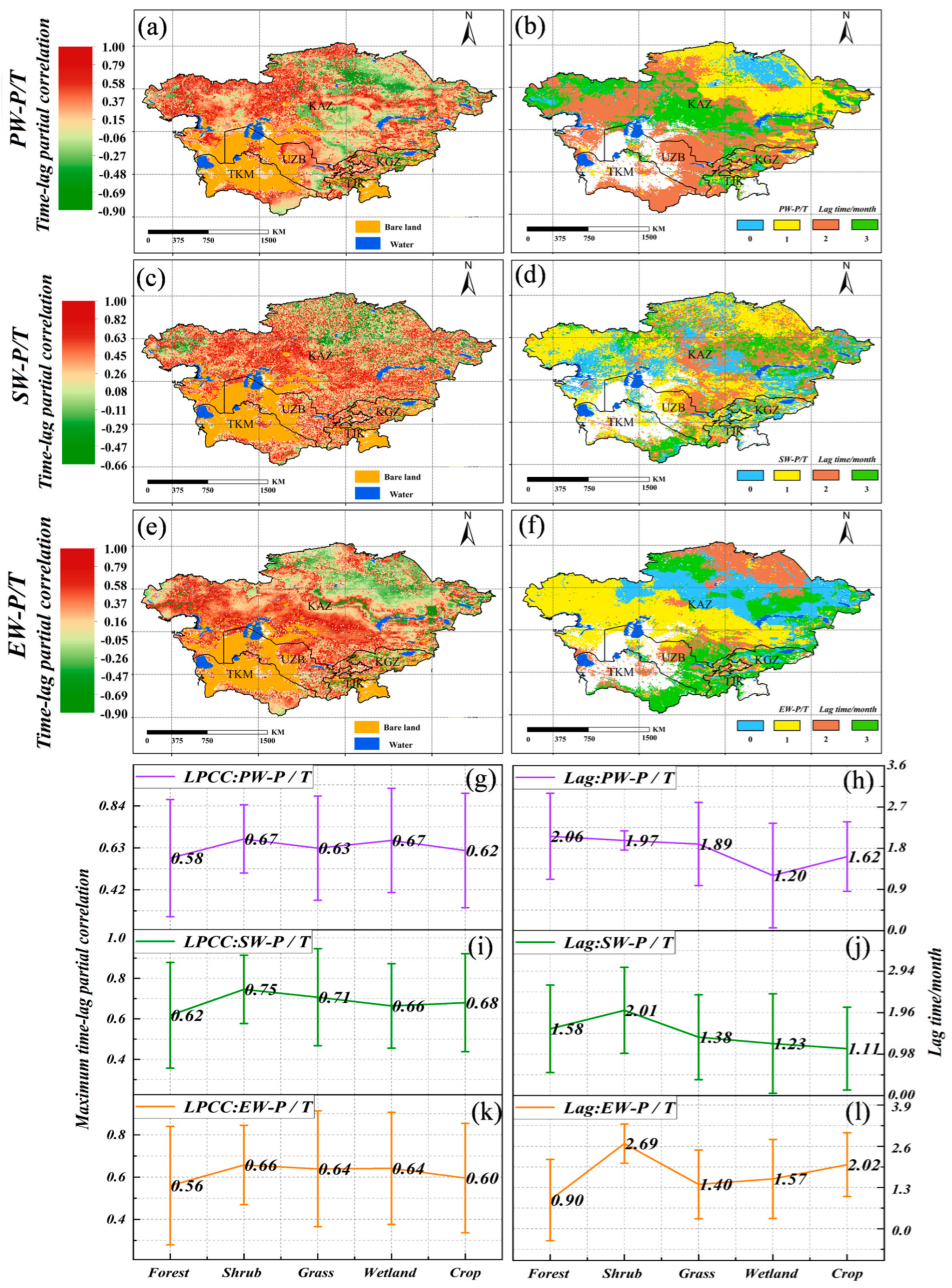
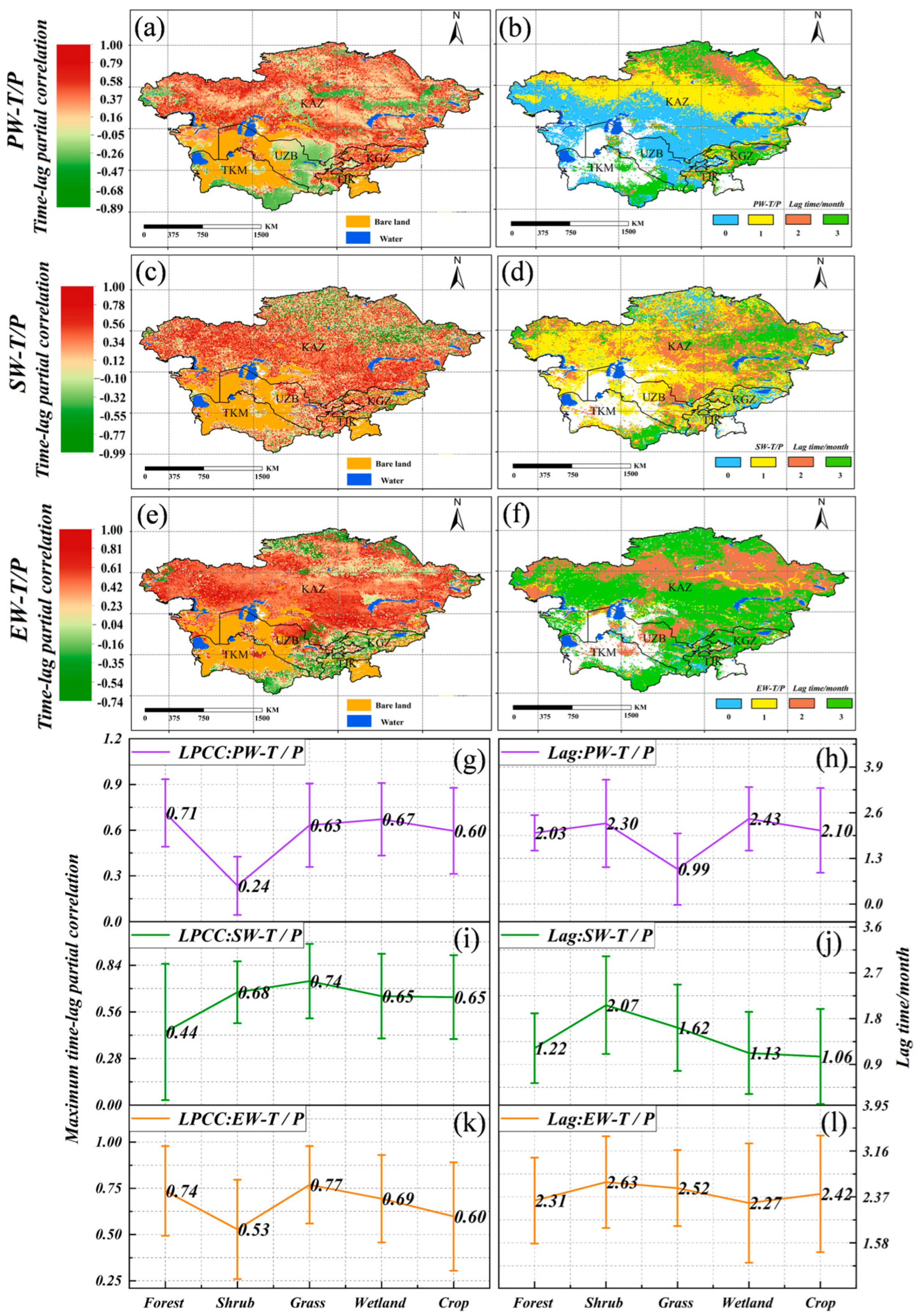
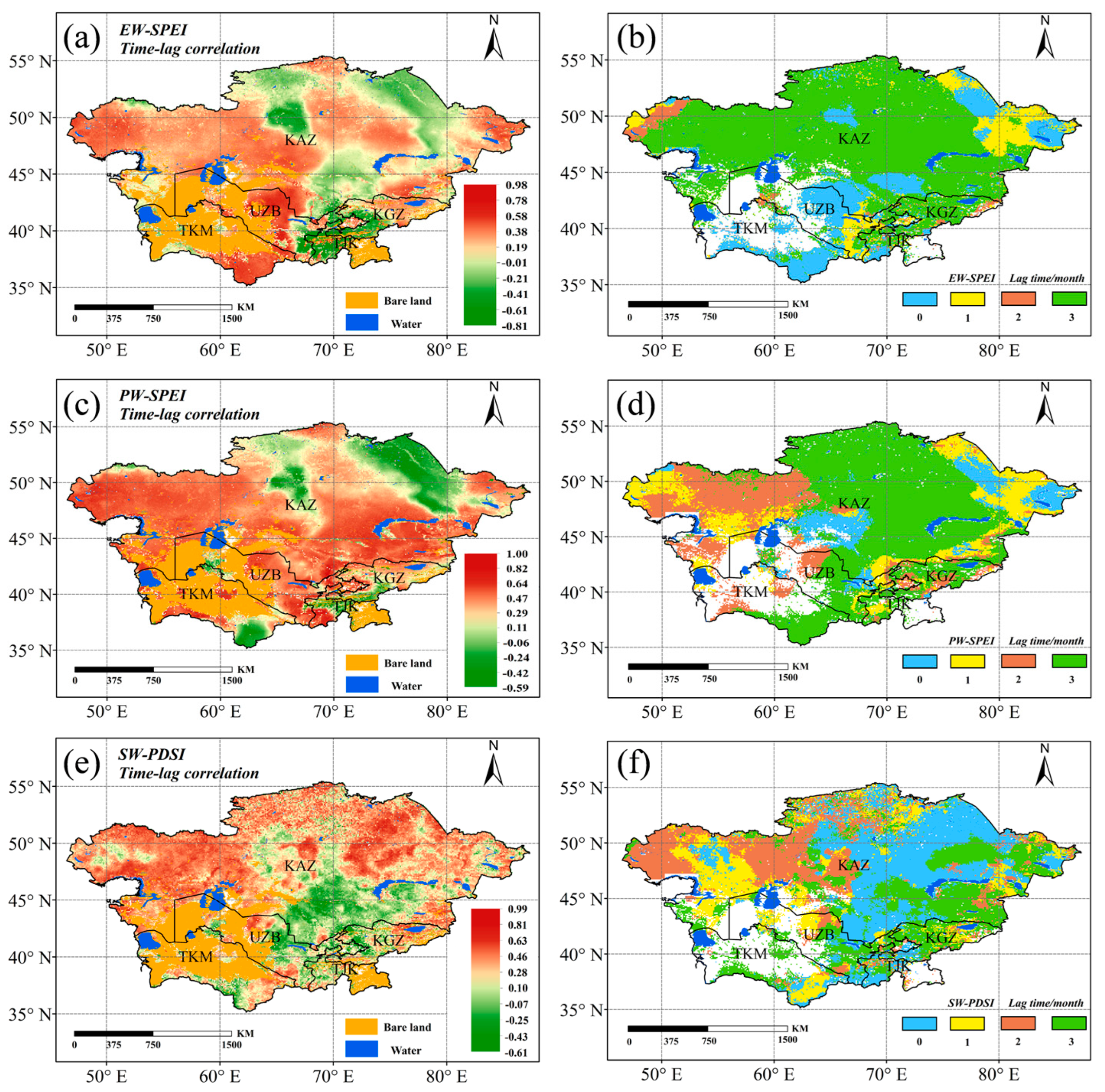
| Serie | Product | Type | Temporal Resolution | Spatial Resolution | Source URL |
|---|---|---|---|---|---|
| MODIS | MOD17A2 | GPP | 8 d | 500 m | https://modis.gsfc.nasa.gov/ (accessed on 5 January 2020) |
| MOD16A2 | ET | 8 d | 500 m | https://modis.gsfc.nasa.gov/ (accessed on 5 January 2020) | |
| MOD13A3 | NDVI | 30 d | 500 m | https://modis.gsfc.nasa.gov/ (accessed on 5 January 2020) | |
| MCD12Q1 | Landcover (IGBP) | 96 d | 500 m | https://modis.gsfc.nasa.gov/ (accessed on 5 January 2020) | |
| ASTER -GDEM | DEM | 2011 | 30 m | http://www.gdem.aster.ersdac.or.jp/index.jsp (accessed on 15 February 2020) | |
| ERA5 | ERA5 | Soil water | monthly | 0.1° | https://www.ecmwf.int (accessed on 17 March 2021) |
| ERA5 | Pre | monthly | 0.1° | https://www.ecmwf.int (accessed on 17 March 2021) | |
| ERA5 | Temperature | monthly | 0.1° | https://www.ecmwf.int (accessed on 17 March 2021) | |
| CRU | CRU4.2.1 | Pre | monthly | 0.5° | https://www.uea.ac.uk/ (accessed on 20 March 2021) |
| CRU4.2.1 | PET | monthly | 0.5° | https://www.uea.ac.uk/ (accessed on 20 March 2021) | |
| CRU4.2.1 | PDSI | monthly | 0.5° | https://www.uea.ac.uk/ (accessed on 20 March 2021) |
| Spring | Summer | Autumn | Winter | |||||
|---|---|---|---|---|---|---|---|---|
| S-Coef | Con-Rate | S-Coef | Con-Rate | S-Coef | Con-Rate | S-Coef | Con-Rate | |
| Pre | 11.40 | 59.65% | −0.37 | 7.02% | −3.04 | −91.27% | −0.02 | 0.14% |
| Tem | 0.80 | 66.16% | 0.20 | 0.28% | 0.93 | −93.03% | −1.04 | 0.08% |
| NDVI | 1.68 | 66.02% | −1.20 | 7.93% | 4.70 | −92.81% | −0.01 | 0.54% |
| Time-Lag Correlation | Lag Time/Month | Veg-Types | Time-Lag Correlation | Lag Time/Month | Elevation | Time-Lag Correlation | Lag Time/Month | |||||||||||||
|---|---|---|---|---|---|---|---|---|---|---|---|---|---|---|---|---|---|---|---|---|
| EW-SPEI | PW-SPEI | SW-PDSI | EW | PW | SW | EW-SPEI | PW-SPEI | SW-PDSI | EW | PW | SW | EW-SPEI | PW-SPEI | SW-PDSI | EW | PW | SW | |||
| KAZ | −0.317 | 0.425 | 0.251 | 1.83 | 2.36 | 1.4 | Forest | 0.494 | 0.7 | 0.632 | 1.24 | 1.29 | 1.69 | AL1 | 0.606 | 0.823 | 0.64 | 2.88 | 1.66 | 1.7 |
| TJK | 0.123 | 0.436 | 0.307 | 2.7 | 2.59 | 2.17 | Shrub | 0.628 | 0.456 | 0.355 | 0.33 | 2.71 | 1.51 | AL2 | 0.38 | 0.545 | 0.456 | 2.19 | 2.2 | 1.39 |
| KGZ | 0.503 | 0.677 | 0.265 | 1.07 | 2.28 | 1.83 | Grass | 0.358 | 0.55 | 0.46 | 2.31 | 2.16 | 1.44 | AL3 | 0.349 | 0.531 | 0.465 | 2.09 | 2.21 | 1.43 |
| UZB | 0.535 | 0.464 | 0.338 | 0.53 | 2.53 | 1.82 | Wetlands | 0.315 | 0.357 | 0.48 | 1.89 | 2.37 | 1.3 | AL4 | 0.148 | 0.501 | 0.347 | 2.46 | 2.28 | 2.02 |
| TKM | 0.365 | 0.553 | 0.495 | 2.45 | 2.13 | 1.38 | Crops | 0.288 | 0.5 | 0.433 | 2.22 | 2.54 | 1.69 | |||||||
Publisher’s Note: MDPI stays neutral with regard to jurisdictional claims in published maps and institutional affiliations. |
© 2022 by the authors. Licensee MDPI, Basel, Switzerland. This article is an open access article distributed under the terms and conditions of the Creative Commons Attribution (CC BY) license (https://creativecommons.org/licenses/by/4.0/).
Share and Cite
Hao, H.; Hao, X.; Xu, J.; Chen, Y.; Zhao, H.; Li, Z.; Kayumba, P.M. Recent Response of Vegetation Water Use Efficiency to Climate Change in Central Asia. Remote Sens. 2022, 14, 5999. https://doi.org/10.3390/rs14235999
Hao H, Hao X, Xu J, Chen Y, Zhao H, Li Z, Kayumba PM. Recent Response of Vegetation Water Use Efficiency to Climate Change in Central Asia. Remote Sensing. 2022; 14(23):5999. https://doi.org/10.3390/rs14235999
Chicago/Turabian StyleHao, Haichao, Xingming Hao, Jianhua Xu, Yaning Chen, Hongfang Zhao, Zhi Li, and Patient Mindje Kayumba. 2022. "Recent Response of Vegetation Water Use Efficiency to Climate Change in Central Asia" Remote Sensing 14, no. 23: 5999. https://doi.org/10.3390/rs14235999
APA StyleHao, H., Hao, X., Xu, J., Chen, Y., Zhao, H., Li, Z., & Kayumba, P. M. (2022). Recent Response of Vegetation Water Use Efficiency to Climate Change in Central Asia. Remote Sensing, 14(23), 5999. https://doi.org/10.3390/rs14235999








